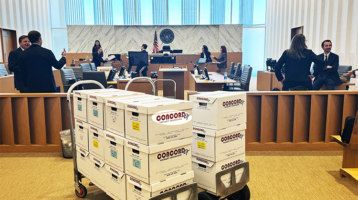How to Prepare a Trial Notebook
Your trial notebook is your blueprint of your case and your road map for trial. Many firms begin by collecting & printing in house. Because of the expense involved while negotiating a settlement, most firms do not prepare until just before trial starts. If you’re in a crunch, you can call CONCORD to help facilitate overnight printing & delivery to the courthouse.
You should begin preparing your trial notebook from the very beginning of your case. If you’re on the plaintiff’s side, this means you’ll start preparing your trial notebook before you even file your petition or complaint. And if you’re on the defense side, you should start putting together your trial notebook as soon as you receive a copy of the petition or complaint.
Your ultimate goal in preparing this trial notebook is to have every relevant part of your case organized and crafted into the story you plan to present a judge or jury at trial.

How do I prepare a trial notebook?
Start building your trial notebook by gathering the following:
1. A three-ring binder for 8 1/2 x 11” paper (legal-sized paper is less common and can be folded to fit inside your binder). If you choose the kind with a clear plastic sheet on the front or back, you can change the cover sheet as needed and reuse the binder for subsequent cases.
2. Paper for a cover sheet. Place the case caption and any other useful information here and slip the cover sheet into the clear plastic sheet on your binder.
3. Colored Tabs. Tabs will help you organize the different sections of your trial binder.
4. Highlighters. Use these to highlight any pertinent information within the contents of your binder.
What sections to I need in my trial binder?
The layout and content of your trial binder is ultimately up to you. One of the first steps is to develop a theme for your side of the case. Your theme is the central story that you want a judge or jury to hear. You will develop that theme with evidence and witnesses as your case progresses through investigation and discovery. If your state has pattern jury charges, these can be an excellent resource in helping you know what issues need to be addressed and what ultimately must be proven at trial.
An associate or paralegal can help you gather the material you plan to use at trial. Generally, you will want to include the following:
- A pleadings section containing copies of all complaints/petitions and answers that have been filed in the matter. Placing these items in reverse chronological order will help you keep the most pertinent material in the front. You may even include any motions in limine and other motions you plan to argue at trial, as well as outlines of the arguments you plan to make.
- Copies of any investigative materials that are central to the case. If this may be too voluminous (as can be the case in matters with substantial medical records), you can include copies of key materials and summaries of the voluminous material. Or you can create multiple binders.
- Witness lists (including contact information) as well as copies of witness statements and deposition testimony that may come up at trial.
- Copies of all documents you intend to introduce at trial or that may be used as rebuttal evidence. As noted above, if this is too voluminous for your trial notebook, you might include summaries containing exhibit numbers instead. At the very least, include a copy of your exhibit list with columns for (1) the exhibit number, (2) a description of the exhibit, and (3) whether the exhibit is admitted or rejected.
- Legal authorities, including statutes and case law that is relevant to your case. You should have a grasp of the important law early in the case. Include copies of any case law, statutes, and regulations that help guide one to the answer of the legal issue(s) in your case.
- Copies of major motions and court orders, including any scheduling order.
- A timeline for the case that outlines the dates (and, if necessary, times) that significant facts occured.
Here are a few other ideas of sections that might go into your trial notebook:
- Trial Team Contact Information
- Initial Case Assessment/Evaluation
- Proof Outline
- Damages Outline
- Pleadings
- Investigation Materials
- Witness Statements
- Witness Outlines
- Discovery
- Deposition Transcripts/Designations
- Discovery Motions
- Motions
- Case Law
- Statement of Facts
- Exhibit List
- Objections to Exhibits
- Direct Examination Outlines
- Cross Examination Outlines
- Deposition Index and Outlines
- Opening and Closing Statement Outlines
- Voir Dire Outline
- Jury Charge
- Trial Briefs
- Pre-Trial Motions
- Trial Motions
- Post-Trial Motions
If you utilize your trial notebook wisely, your case might even settle beforehand because your opponent can see that you are prepared to try the case.


